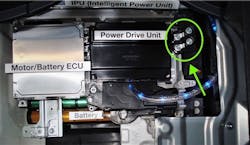Understanding Hybrids, Plug-In, Electric & Fuel Cell Service
What if the only thing you learn is to stay away from “orange cables?” How will we ever transition to electric vehicles?
This is the first article in a series. In each edition we will offer you a new lesson in repairs of hybrid and electric cars and trucks. Think of this as the latest version of a correspondence course with bi-monthly installments showing up in your mailbox, just like my father and grandfather did in the old days.
Training, for those seeking a “high voltage” education in hybrids, plug-ins and fuel cell vehicles, is necessary to stay in business. The intent of these articles is to lay out a plan for you to learn about the components; but before we do, it must start with safety. I know you have had many high voltage safety classes and are tired of it. I will make this short and to the point. If you are a pro and have been working on hybrids for over two decades, I know you will still find value in this series.
The Automotive Career Development Center (ACDC) has been training technicians worldwide for a long time.
You will see the metric equivalent in brackets as you read, as the internet makes these articles available everywhere. Most technicians use the metric system outside the U.S.
We must establish the terms and concepts that will be used throughout this series, so we have a free glossary posted on our company’s website (www.FIXEV.com/glossary). Use it as you read so you can follow along.
If you were trained on the West Coast of the USA, the term “battery electric vehicle” (BEV) is commonly used. If you are from the Eastern part of America, the most widely used name is “electric vehicle” (EV). I live and work 40 miles outside of Boston, Mass., so it is EV.The “12-volt alternator” in a conventional vehicle is often called a generator, but we will refer to that 12-volt component as an “alternator” so it will not be confused with what we call a “motor/generator” (M/G) in a high voltage system.
These articles are excerpts from my new college-level Hybrid, EV and Fuel Cell book. It's written by an automotive technician — me.
Around the year 2010, my company, ACDC, coined the term “EMV” (Electrified Motor Vehicle). We will use that term, “EMV”, in these articles. An EMV is used to describe any hybrid (HEV), plug-in hybrid (PHEV), electric vehicle (EV), electric car with range extender (EV-RE), fuel cell (FCEV), or plug-in fuel cell (PFCEV). We will, of course, define each of these types separately, but when we discuss EMVs we are referring to these six types as a group. If we reference a hybrid, plug-in hybrid, battery electric vehicle, or fuel cell it is because the topic is specific to that type of EMV.
The 12-Volt Brain
When you first learned about cars with a 12-volt system that ran on gasoline or diesel you were, without knowing it, developing what I call a “12-volt brain.” When you were a small child and stood by the family car (or a friend’s car) you did not have to be told what a car sounded like when it was cranking and running. If it would not start, you heard that familiar “rur...rur… rur” and maybe “click … click ... click” and then nothing. You may have learned a few adult words at that moment, too!
That experience as a young child becomes locked into our brains as something that all cars or trucks do, until EMVs entered the picture. The “12-volt brain” was learning even before you knew you wanted to fix these things. Your brain may be in conflict with some of that intrinsic knowledge, so you must relearn what a high voltage system can do, which was not possible with a mere 12 volts.
It is time to develop a high voltage brain. This will be exciting and challenging. It will lead to a revolution in transportation comparable to what was last seen between 1890 and 1910. Those two decades set the stage for an affordable, internal combustion, carbon-based, fuel-powered world. The future is electric and it is time to learn the how and why, so you are able to transition into a sustainable, zero carbon and livable planet.
What do you need to know about the hazards of high voltage, chemicals and other safety issues? Be aware of your need for personal protection as well as protection for those around you. The trade-off for profit and speed versus safety and responsibility needs to be balanced.
In the beginning, take the time needed to be safe. The speed will come after the learning. If you are not afraid of working on high voltage systems you are either extremely well trained already or very naive. If you have any doubts about a future in the automotive, heavy duty truck, bus or the two wheeled repair industry; make sure you study circuits, wiring diagrams and the proper use of all the electrical equipment. You will need this foundation to analyze, diagnose and test electrical systems of any voltage, from 5 volts to 1,000 volts. Some heavy duty vehicles are now in development that will use systems that are over 1,000 volts DC. To master the electrical side of modern EMVs, it starts with the basics. These articles are not about the basics, so make sure you get that training in the fundamentals of electricity. When you don’t know what someone is saying, or having a hard time understanding them, you are learning. You can contact me via email with any questions you may have. (My address is listed below.)
Do you really need to be told that orange cables carry high voltage? What if you are inside a Honda Insight (M/Y 2010 to 2014) and the HV connection from the HV battery to the HV capacitors are not orange? What then?
Each OEM has their own way of doing things. Never assume a Prius is the only hybrid that you need to learn about. Toyota technicians are at risk applying their training to a Honda. ASE has a HEV-EV test known as L3. The four key positions are Off, Accessories, Power On, and Ready to Drive. We will reference them as we learn. Did you know that a Toyota keeps the HV battery off until you enter “READY”, but Honda connects the big battery when in “POWER ON” mode in their IMA hybrids? Knowing when the high voltage system is powered up is a good first step in staying safe.
Are you ready for hybrids and EVs? If not, make sure you read the next installment about the difference between high voltage and low voltage. Don’t forget the high voltage safety gloves.
About the Author

Craig Van Batenburg
Craig Van Batenburg is the CEO of ACDC, a hybrid and plug-in training company based in Worcester, Mass. ACDC has been offering high voltage classes since 2000, when the Honda Insight came to the USA. When EVs were introduced in 2011, ACDC added them to their classes. Reach Craig via email at [email protected] or call him at (508) 826-4546. Find ACDC at www.FIXHYBRID.com.
